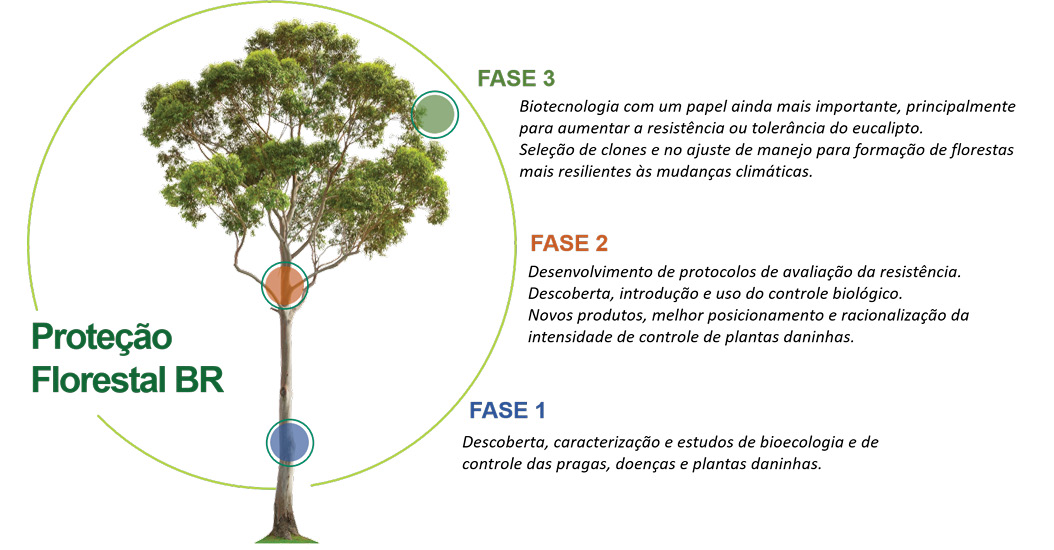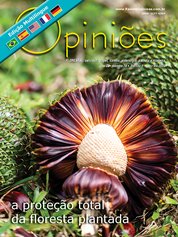Reginaldo Gonçalves Mafia
Gerente de Tecnologia de Manejo Florestal da Suzano
OpCP70
A nova era da proteção florestal
No Brasil, os plantios de eucalipto atingiram 7,53 M ha no último ano. Apesar do crescimento mais acelerado recentemente, a disponibilidade de madeira ainda é um fator que dificulta o aumento da capacidade produtiva da indústria de celulose e papel, bem como a produção de novos produtos a partir da biomassa florestal. Adicionalmente, as mudanças climáticas, o surgimento de novas pragas e doenças, a expansão para novas regiões, onde naturalmente existe menor conhecimento do ambiente, são fatores limitantes para o aumento da produtividade e, consequentemente, para oferta de madeira. Nesse contexto, a proteção dos plantios de eucalipto contra perdas torna-se ainda mais relevante.
A proteção florestal passou por uma grande evolução nas últimas décadas. De forma didática, podemos separar esse progresso em três períodos. O primeiro, entre as décadas de 1980-2000, compreendeu a fase de descoberta, caracterização e estudos de bioecologia e de controle das pragas, doenças e plantas daninhas. Na sequência, entre 2000 até 2020, foram desenvolvidos os protocolos de avaliação da resistência dos clones de eucalipto para pragas e doenças, bem como se intensificou o uso do controle biológico.
Nesse mesmo período, ocorreu a introdução do manejo integrado de plantas daninhas. A partir de 2020, é possível distinguir uma nova fase, na qual o uso da biotecnologia deverá assumir um papel ainda mais importante, com o emprego do eucalipto geneticamente modificado, podendo conferir características de aumento da produtividade, resistência às pragas e tolerância aos herbicidas. Além disso, considerando o cenário atual, nessa terceira fase, é fundamental investir na seleção de clones e no ajuste do manejo para formação de florestas mais resilientes às mudanças climáticas.
Nesse mesmo período, ocorreu a introdução do manejo integrado de plantas daninhas. A partir de 2020, é possível distinguir uma nova fase, na qual o uso da biotecnologia deverá assumir um papel ainda mais importante, com o emprego do eucalipto geneticamente modificado, podendo conferir características de aumento da produtividade, resistência às pragas e tolerância aos herbicidas. Além disso, considerando o cenário atual, nessa terceira fase, é fundamental investir na seleção de clones e no ajuste do manejo para formação de florestas mais resilientes às mudanças climáticas.
A transformação genética é uma excelente ferramenta para agregar características desejáveis para aumento da produtividade e qualidade da madeira, seja de forma direta ou por meio do uso mais eficiente dos recursos do ambiente e/ou aumento da resistência da planta. Normalmente, para obter ganhos diretos de crescimento, como se trata de características quantitativas, o processo envolve mais genes e tem maior complexidade. Por outro lado, para agregar um atributo qualitativo, por exemplo, resistência a uma praga ou tolerância a um determinado herbicida, o processo é mais simples comparativamente, envolvendo um ou poucos genes.
Essa diferença de complexidade e de potencial de ganho, bem como a forma de sincronizar os avanços do programa convencional de melhoramento e a transformação genética, precisa ser considerada na definição de uma boa estratégia de desenvolvimento clonal do eucalipto. Já existem clones de eucalipto transformados geneticamente para aumento da produtividade de madeira e para tolerância ao herbicida glifosato. Outros eventos geneticamente modificados para resistência a insetos-praga estão sob avaliação da Comissão Técnica Nacional de Biossegurança – CTNBio. Embora essas tecnologias já estejam em uso de forma segura na agricultura, em função das barreiras de certificação florestal, os plantios de eucalipto geneticamente modificados ainda estão sendo realizados em escala-piloto experimental.

Essa realidade precisa ser alterada frente aos potenciais ganhos. No caso do eucalipto tolerante ao glifosato, além do menor risco de perda de produtividade causada por fitotoxicidade das derivas, espera-se o aumento da segurança do trabalho, pois será possível utilizar aplicações totalmente mecanizadas, com maior eficiência, menor custo e exposição para os trabalhadores.
Sob o ponto de vista ambiental, existe a oportunidade de otimizar o uso de herbicidas, uma vez que será possível melhor posicionar o momento da aplicação. Outro exemplo interessante é o desenvolvimento de eucalipto com resistência às pragas. Nesse caso, além da redução dos custos de controle, vale destacar a eliminação das perdas e do uso de inseticidas para o controle, representando um grande passo para a redução do uso de agrotóxicos. É importante mencionar que essas tecnologias fazem parte do manejo integrado como ferramenta adicional. Vale lembrar que a melhor forma de aumentar a sustentabilidade ambiental, para a produção vegetal, continua sendo atingir maior produtividade, pois, assim, seremos ainda mais eficientes no uso dos recursos e com menor demanda de área para cultivo.
Até um certo tempo, a possibilidade de ganho com o uso de eucalipto geneticamente modificado parecia uma realidade distante, pois não existiam eventos comprovadamente eficientes, e as certificações não permitiam o plantio em escala comercial. Essa realidade foi alterada e, atualmente, já existem eventos eficazes e aprovados, comprovadamente seguros para a saúde humana, animal e meio ambiente.
Por outro lado, não houve uma evolução na política das certificações florestais, que ainda não consideram o avanço da ciência e a evolução mundial dos sistemas regulatórios. Para se fazer um comparativo, para as principais culturas agrícolas, o uso de cultivares transgênicos já é uma realidade há mais de 20 anos, e, diariamente, alimentos advindos desses plantios são consumidos.
Importante mencionar que a Lei Nacional de Biossegurança e as Resoluções Normativas da CTNBio são criteriosas e eficientes para avaliar, monitorar e regular o uso de organismos geneticamente modificados. Não reconhecer essa competência por parte das agências certificadoras e flexibilizar o uso de biotecnologias seguras é, no mínimo, um contrassenso, com impactos sobre a competividade do setor florestal e para obtenção dos ganhos ambientais.
Em outra área importante para a proteção florestal, as bases do conhecimento sobre avaliação foram desenvolvidas contra agentes bióticos. Essas avaliações visam determinar e selecionar fenótipos de resistência contra pragas e patógenos, processo denominado de “fenotipagem”. Daqui para frente, no entanto, considerando as mudanças climáticas e as variações mais significativas do clima, torna-se fundamental desenvolver metodologias para selecionar clones mais resilientes aos fatores abióticos. Dentre esses fatores ligados ao ambiente, a resistência ao déficit hídrico nos parece mais relevante, pois, nas principais regiões de cultivo do eucalipto, os eventos de secas drásticas têm se tornado uma constante cíclica.
Sendo assim, estamos investindo na caracterização de marcadores fisiológicos e em técnicas para seleção de clones mais tolerantes ao déficit hídrico e mais adaptados para plantio em solos arenosos. O crescimento do eucalipto ou de qualquer outra planta está condicionado ao efeito do genótipo, do ambiente e da interação desses fatores. Considerando que o ambiente está cada vez mais variável, no espaço-tempo, é importante repensar a forma de realizar o melhoramento genético e o manejo dos plantios de eucalipto. Caso contrário, não conseguiremos alcançar maiores patamares de produtividade e minimizar as perdas causadas pelos agentes daninhos, sejam eles fatores bióticos ou abióticos.




